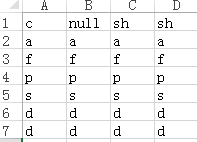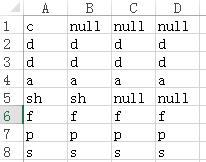博客转载自:http://blog.csdn.net/lime1991/article/details/44536343
1.什么是对齐?为什么要对齐?
2.pragma pack语法
作用:指定结构,联合和类的包对齐方式(pack alignment)
show(optical):显示当前packing aligment的字节数,以warning message的形式显示。
push(optical):
Pushes the current packing alignment value on the internal compiler stack, and sets the current packing alignment value to n. If n is not specified, the current packing alignment value is pushed.
pop(optical):
Removes the record from the top of the internal compiler stack. If n is not specified with pop, then the packing value associated with the resulting record on the top of the stack is the new packing alignment value. If n is specified, for example, #pragma pack(pop, 16), n becomes the new packing alignment value. If you pop with identifier, for example, #pragma pack(pop, r1), then all records on the stack are popped until the record that hasidentifier is found. That record is popped and the packing value associated with the resulting record on the top of is the stack the new packing alignment value. If you pop with an identifier that is not found in any record on the stack, then the pop is ignored.
identifier(optional):
When used with push, assigns a name to the record on the internal compiler stack. When used with pop, pops records off the internal stack until identifieris removed; if identifier is not found on the internal stack, nothing is popped.
n (optional):
Specifies the value, in bytes, to be used for packing. If the compiler option /Zp is not set for the module, the default value for n is 8. Valid values are 1, 2, 4, 8, and 16. The alignment of a member will be on a boundary that is either a multiple of n or a multiple of the size of the member, whichever is smaller.
3.结构体对齐规则
2)将各数据成员内存对齐,按各自对齐模数而填充的字节数累加到和sum_a上,记为sum_b。对齐模数是【该数据成员所占内存】与【#pragma pack指定的数值】中的较小者。
3)将和sum_b向结构体模数对齐,该模数是【#pragma pack指定的数值】、【未指定#pragma pack时,系统默认的对齐模数8字节】和【结构体内部最大的基本数据类型成员】长度中数值较小者。结构体的长度应该是该模数的整数倍。
3.1 基本数据类型所占内存大小

以下例子均按32bit编译器处理。
3.2 Test1
#pragma pack(4) struct Test1 { char c; short sh; int a; float f; int *p; char *s; double d; };
总共占28Bytes。 c的偏移量为0,占1个Byte。sh占2个Byte,它的对齐模数是2(2<4,取小者),存放起始地址应该是2的整数倍,因此c后填充1个空字符,sh的起始地址是2。a占4个Byte,对齐模数是4,因此接在sh后存放即可,偏移量为4。f占4个字节,对齐模数是4,存放地址是4的整数倍,起始地址是8。p,s的起始地址分别是12,16。d占8个字节,对齐模数是4(4<8),d从偏移地址为20处存放。存放后结构体占28个字节,是4的整数倍不用补空字符。

struct Test2 { char c; double d; int a; short sh; float f; int *p; char *s; };
将Test1个变量的顺序换一下位置,结构体Test2占用内存32Byte,可见写结构体时,将各个变量按所占内存从小到大排列所占结构体所占内存较小。

3.3关于静态变量static
静态变量的存放位置与结构体实例的存储地址无关,是单独存放在静态数据区的,因此用siezof计算其大小时没有将静态成员所占的空间计算进来。
#pragma pack(4) struct Test3 { char c; short sh; int a; float f; int *p; char *s; double d; static double sb; static int sn; };
sizeof(Test3)=28
3.4关于类
空类是会占用内存空间的,而且大小是1,原因是C++要求每个实例在内存中都有独一无二的地址。
(一)类内部的成员变量:
- 普通的变量:是要占用内存的,但是要注意对齐原则(这点和struct类型很相似)。
- static修饰的静态变量:不占用内容,原因是编译器将其放在全局变量区。
(二)类内部的成员函数:
- 普通函数:不占用内存。
- 虚函数:要占用4个字节,用来指定虚函数的虚拟函数表的入口地址。所以一个类的虚函数所占用的地址是不变的,和虚函数的个数是没有关系的
#pragma pack(4) class cBase{};
sizeof(cBase)=1
- 3.4.1 不包含虚函数的类
#pragma pack(4) class CBase1 { private: char c; short sh; int a; public: void fOut(){ cout << "hello" << endl; } };
不包含虚函数时,对于类中的成员变量按结构体对齐方式处理,普通函数函数不占内存。sizeof(CBase1)=8
3.4.2 包含虚函数的类
#pragma pack(4) class CBase2 { private: char c; short sh; int a; public: virtual void fOut(){ cout << "hello" << endl; } };
包含虚函数时,类中需要保存虚函数表的入口地址指针,即需要多保存一个指针。这个值跟虚函数的个数多少没有关系。sizeof(CBase2)=12
3.4.3 子类
子类所占内存大小是父类+自身成员变量的值。特别注意的是,子类与父类共享同一个虚函数指针,因此当子类新声明一个虚函数时,不必在对其保存虚函数表指针入口。
#pragma pack(4) class CBase2 { private: char c; short sh; int a; public: virtual void fOut(){ cout << "virtual 1" << endl; } }; class cDerive :public CBase { private : int n; public: virtual void fPut(){ cout << "virtual 2"; } };
sizeof(cDerive)= sizeof(cBase)+sizeof(int n) = 16